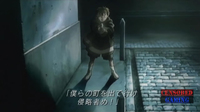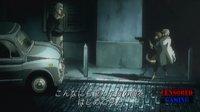Part 15: Mission 15 – Operation Firefly, July 10th, 2005
EmancipationMission 15: Operation Firefly – July 10th, 2005
Overview: ISAF launches a massive ground assault in coordination with the local Resistance fighters to liberate the city of San Salvacion from Erusean occupation. Mobius 1 and the ISAF Air Strike Team are sent in to provide top cover for the ground forces as they retake the city.
Meanwhile, the Storyteller Boy and Barkeep’s Daughter have their long awaited reckoning with Yellow 13.
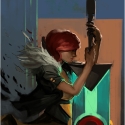
Guest Commentator: I am joined for this mission by Pythonicus, one of our brand new guest commentators for Ace Combat 04. Pythonicus has done LPs of Call of Duty: Modern Warfare 2 and Modern Warfare 3, and has also appeared in Lazyfire’s LP of Battlefield 4 (which I also appear in alongside Blind Sally!). He is currently (and by that I mean the LP is on hiatus but technically not dead yet) running an LP of Bungie’s popular “No, Peter Dinklage does not give a solid shit about this game” simulator: Destiny.

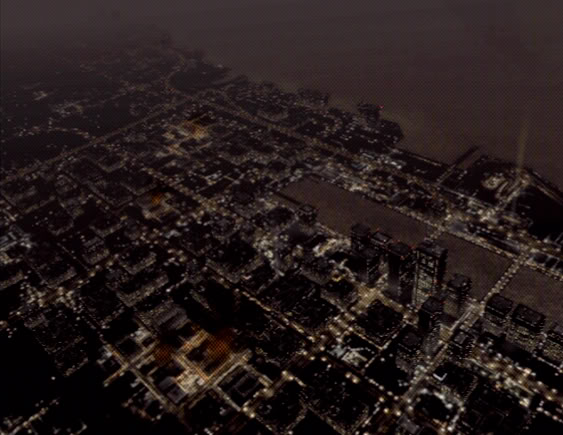
SAN SALVACION
San Salvacion City is the capital of the nation of San Salvacion. Located on the shore of a large lake in the lowlands north of the Lambert Mountains, the majority of San Salvacion’s national population lives either in the capital, or further north towards the coast. The city itself is divided into three key regions, the downtown government complex, where the bulk of the local occupying Erusean military command has been stationed, the Old Towne district, which encompasses the original city limits and is where the interstitial narrative cutscenes featuring the Storyteller Boy and Yellow 13 have been taking place, and the modernized New City district, which is where both Yellow Squadron’s makeshift highway tunnel hanger base and the San Profetta International Airport are located.
For over a century, San Salvacion the country has prided itself on its political neutrality and its commitment to peace and modest prosperity. As the largest of the Independent States, the nation has long acted as a diplomatic buffer in the often contentious relationship between the Federation of Central Usea and the Federal Republic of Erusea. When the Eruseans invaded Delarus and seized control over the Stonehenge Turret Network, San Salvacian ambassadors and diplomats attempted to negotiate a peaceful end to the Shattered Skies crisis in its early days and for the Eruseans to peacefully return control of the STN complex back to the FCU in exchange for the lifting of sanctions and increased foreign aid. When the Eruseans began shelling ISAF facilities with Stonehenge and invaded San Salvacion itself, all diplomatic ties were formally severed with Erusea and any notion of a peaceful end to the conflict was abandoned by the FCU government.
In keeping with its geopolitical neutrality and strong culture of pacifism, San Salvacion has no standing army, navy, or air force of its own, and is instead protected under ISAF’s military umbrella. Many brave young men and women from San Salvacion serve in ISAF’s peacekeeping corps., though with the outbreak of armed conflict once again on Usea, many of them have transferred to active duty positions in order to help liberate Usea and their homeland from Erusean occupation. This reliance on ISAF for protection, however, ultimately left San Salvacion vulnerable to invasion from Erusea at the start of the war. Prior to the outbreak of the war, an agreement between Erusea and the FCU saw ISAF forces withdrawn from the San Salvacion-Erusea border in the hopes of restoring functional diplomatic relations between the two Usean power blocs, which had been strained by the one-two punch of the first Continental War of 1998 and Ulysses Day in mid-1999. When ISAF was forced to evacuate eastward following Erusea’s seizure of Stonehenge, San Salvacion was effectively left to twist in the wind. The ISAF remnants left behind in San Salvacion were forced to engage in asymmetric warfare with the Erusean occupying forces by helping to arm and equip the local San Salvacion Resistance forces and keeping the SSR in contact with ISAF GHQ, first on North Point, and later in Los Canas.
San Salvacion both as a nation, and as capital city, has a long and unfortunate history stretching all the way back to medieval times of becoming a battlefield in someone else’s war. The country was the site of many battles between the western settlers from Sapin and the Usean natives all the way up through the 1700s. In the late 1800s and early 1900s, the country saw turmoil as civil war and revolutions upended weak and corrupt governments. And in the late 90s, San Salvacion fell under the thrall of the Usean Rebel Forces during the Continental War.
While San Salvacion itself (along Erusea and the other northern Usean nations) originally opposed the motion by the Southern FCU states to join the Osean Federation, it did not support the open rebellion against the FCU government or the URF’s attempt to stage a coup against the governments of Usea and install anti-Osean military rule over the entire continent. After the Rebels were defeated at St. Ark and Fortress Intolerance, the San Salvacion government helped lead the charge to restructure the FCU Allied Forces into the Independent States Allied Forces in order to help prevent another Usean civil war.
The term San Salvacion, or more pointedly san salvación, means “Saint Salvation” in Spanish. And you can see the Spanish influence at play very strongly over the story sections. The architecture of San Salvacion resembles that of an old Spanish or at least vaguely far western European city that’s gone through the throes of modernization. The musical interludes associated with San Salvacion all feature the Spanish guitar and were heavily influenced by Agustín Barrios, a Paraguayan guitarist of Spanish descent. And it’s been pointed out several times in both this thread and the Ace Combat 2 Erusea as an occupying force draws heavily from Franco’s nationalist Spain, which we’ve already briefly touched on earlier in the LP.

NARRATIVE CONVERGENCE
As Pythonicus and I discussed over the video, this is the mission where the two disparate threads of Ace Combat 04’s narrative—the Storyteller Boy’s story and Mobius 1’s story—finally merge, albeit obliquely. Up till this point, there hasn’t been any hard evidence pointing to where the Storyteller Boy’s narrative is taking place in, just that it’s been in somewhere still under Erusean occupation and close to Stonehenge. After the mission ends, the follow up cutscene reveals the frame story to have in fact been taking place in San Salvacion all along. In this mission, Mobius 1 and the Storyteller Boy are in the closest proximity to one another that they will get (in the frame narrative, anyway), though as the gameplay story moves on westward into Erusean territory, the Storyteller boy will be hot on Mobius 1’s heels from here on out. Now that the two narratives have basically merged into a single story, they’re not going to be pulling apart anytime soon in our mad dash to the end of the game.
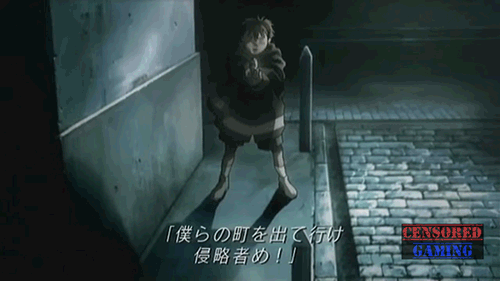
MORE CENSORED MATERIAL
The pre-mission cutscene to Emancipation also features our last bit of censored material between the Japanese and North American/European release of 04. The gun the Storyteller Boy pocketed from the drunken Erusean soldier back near the start of the game finally comes into play here. When Yellow 13 confronts the Barkeep’s Daughter over her connection to the Resistance and her role in Yellow 4’s death, the narrator draws his gun on him and threatens to shoot 13 in order to protect the girl. His affection for 13 ultimately prevents him from pulling the trigger, opting instead for a few choice words said in the heat of an anger that had been struggling to find expression since the day his family died.
In the North American version, the pistol is not present, and the Storyteller Boy confronts 13 unarmed. This small change shifts the dramatic tension and balance of power in the scene drastically. In the original version, the scene turns on whether or not the narrator is going to shoot 13. With a deadly weapon at the ready and aimed at point blank range, the Storyteller Boy is the threat in this scene, holding the power to kill 13 at his pleasure if he so chooses. The scene turns on the question of how strong the narrator’s lust for revenge is, and whether his (by now shattered) friendship with 13 is enough to stay his hand.
In the localized version, the scene turns on how strong 13’s basic human decency actually is and whether he will let the narrator and the Barkeep’s Daughter go before the Erusean MPs arrive and take them into custody and—most likely—to a swift summary execution for being enemy combatants. In this version of the scene, 13 holds all the power and is the threat because he is an adult and a military officer at that who is confronting a pair of helpless teenagers, children really. It’s a “power” position that the gun in the Storyteller Boy’s hand renders instantly impotent. And just as the narrator cannot bring himself to shoot 13 in the Japanese version because of his affection for him, 13’s affection for the two kids, both as friends and as a surrogate son and daughter of sorts proves too strong and he lets them escape into the night rather than do his duty as an Erusean soldier and take them both into custody for being active Resistance members.
Again, the reasons for this scene’s alteration are patently obvious, namely cultural sensitivities involving depictions of children wielding deadly weaponry, particularly firearms, in mass media. Ultimately, the choice to show the Storyteller Boy with a gun was intended to act as a statement on the corrupting influence of war and occupation on the lives of everyone unfortunate enough to live through it. These situations have happened in real life and in recent memory; children in war zones forced to or choosing to pick up weapons and become soldiers of one sort or another. It’s simply something western audiences aren’t immediately familiar with because it hasn’t happened here. So it’s not exactly like Project Aces was skirting the bounds of the unrealistic here with this sub plot or anything. I get what they were going for and I’m not bothered by it in the slightest, nor I doubt would I have been back when I first played the game as a teenager if I’d seen it unedited then. But that was Namco’s localization team’s call, not anyone else’s.
For what it’s worth, PA apparently took the message from getting whacked with the censor stick to heart and has thus far strayed away from broaching any more white hot taboo subjects in Ace Combat games, and as such no other Ace Combat beyond Shattered Skies has seen the Big Red N come down upon it with the cutting room blade. The next time child characters appear in a warzone setting is in Ace Combat 6 coming up two games from now, and when they do they are utterly safe and boring and annoying and I actually kind of wish that little girl just picked up a gun and capped Pasternak with it. It would have maybe made her likable and sure as shit would have saved me a lot of trouble… and screaming (though I actually have a bit of a soft spot for the great Flying D-Bag of Easto-Slavia, so maybe not?).
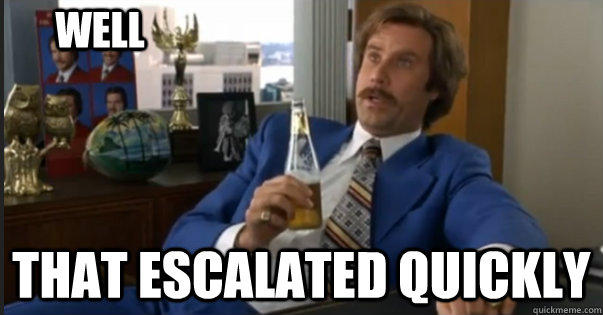
TOTAL UPHEVAL
As of Emancipation, Shattered Skies has begun its mad dash toward the finish line and all the storylines have just been thrown into a blender, set to liquefy, and then the blender was tossed into a cannon, which itself was strapped to a scramjet and launched across a dry lake bed. EVERYTHING starts happening in this mission after seemingly being stuck a in a holding pattern for most of the game.
Emancipation is the start of Shattered Skies’s “narrative collapse,” a relatively obscure term from certain circles of literary theory that basically amounts to the point of no return for an ongoing story pertaining to that story’s status quo. Episodic stories that suddenly shift gears and enter a final story arc in preparation for a finale tend to undergo a narrative collapse of some sort, usually stemming from a single moment after which any attempt to re-establish the running status quo becomes impossible or can only be done at the cost of fundamentally breaking the story.
There is no putting the status quo back together after what happens in the beginning and end of this video. The Storyteller Boy’s relationship with Yellow 13 is broken beyond repair at this point, regardless of whatever lingering feeling he may have about 13 himself. Likewise, with the Eruseans now run out of San Salvacion completely, their confrontation in the street the night before the ISAF assault on the city is basically the last real interaction he ever has with Yellow 13. The follow up scenes with 13 are all shown from a distance, suggesting the boy is still observing 13, but never again comes close to him perhaps out of shame, anger, or some mixture of the two. This is also, without spoiling anything, the last time we physically see Yellow 13 in person in the game. When the Eruseans abandon San Salvacion, 13 does not stick around.
So it should come as no shock then that with Yellow 13 out of the picture, and Mobius 1 never crossing paths with the Storyteller Boy physically, that the story segments from here to the end are going to be few and far between. Their story is not over just yet, however, it’s just that the way it is going to be told is going to shift a little now that we have entered the narrative collapse.
From Mobius 1’s perspective, the narrative collapse of Ace Combat 04 has also begun in that the war is rapidly approaching its climax. ISAF has effectively retaken roughly 90% of the territory they controlled prior to the start of the game and is about to make the push into Erusean territory for the first time. As Intel says over the debriefing, the retaking of San Salvacion is an important victory both strategically and symbolically. Strategically, ISAF now has a springboard to launch its final assault on Erusea from now that the city has been retaken. Symbolically, liberating San Salvacion was probably an even bigger victory than the destruction of Stonehenge because the city was the last vestige of occupied territory held by the Eruseans. With San Salvacion restored to its rightful rulers and people, the message has gone out around the world that Usea is a free continent once more. Now all that remains is bringing the Erusean military government command to justice for its crimes.
At this point, the writing is basically on the wall for Erusea. They have lost this war. The question now shifts to when are they going to realize it and surrender, or are they going to go down fighting to the bitter end? Or are they going to follow Belka’s example into the abyss and let their own stubborn pride goad them into doing something truly monstrous?
Let’s find out.

Aircraft featured in Mission 15: Operation Firefly

Ka-50 Hokum A
Manufacturer: Kamov
Role: Attack helicopter
Manufactured: 1990–present
Status: In service
Primary Operators: Russia, Egypt
Quick Facts:
- Appears in Ace Combats 04, Assault Horizon, and Infinity.
- Features a distinctive coaxial contra-rotating rotor assembly.
- The coaxial rotor assembly improves the helicopter’s stability greatly, completely eliminating the need for a tail rotor stabilizer.
- It also allows the Ka-50 and its variants to pull off maneuvers otherwise impossible with regular single rotor helicopter craft like loops, circle strafing, and barrel rolls.
- “That’s not planes!” – FPzero, 2016
- Known by the NATO reporting name “Hokum”.
- In Russia the Ka-50 is known as the “Chornaya Akula” or “Black Shark”.
- Has several production variants including the tandem cockpit Ka-52 “Alligator”, and the Turkish export model the Ka-50-2 “Erdogan” made in cooperation with Israeli Aerospace Industries.
- Currently the only helicopter in active service with an ejector seat system (h/t: radintorov).
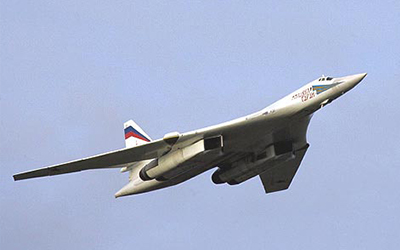
Tu-160 Blackjack
Manufacturer: Tupolev
Role: Strategic bomber
Manufactured: 1984–1992, 2000, 2008
Status: In service
Primary Operators: Russia
Quick Facts:
- Appears in Ace Combats 04 and Assault Horizon.
- Was the last strategic bomber designed and built by the Soviet Union prior to its collapse in the early 90s.
- Is the largest and heaviest supersonic aircraft ever built.
- Its design bears striking similarities to the US B-1B Lancer bomber including its variable geometry wing configuration.
- However, it was actually created to be a rival platform to the XB-70 Valkyrie supersonic bomber, which the US ultimately abandoned.
- Known by the NATO reporting name “Blackjack”.
- In Russia the Tu-160 is known as the “Beliy Lebed” or “White Swan”.
- Only 16 Tu-160s remain in airworthy condition, though the Russians are attempting to modernize them with a program that has been underway since the early 2000s, producing the Tu-160M.
- The Tu-160 (and the Tu-95 Bear) are scheduled to be replaced by the still under development Tupolev PAK-DA bomber, due for roll out in 2025.

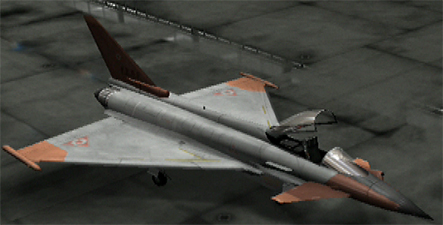
-
Olmstead
- Plane: EF-2000 Typhoon
- Mission 15
- Spawn conditions: Appears in the center of the map over the mountains between the three mission areas after the mission update.
Kadorhal posted:
Ace Number Fifteen is Olmstead. Named for C. Michelle Olmstead, apparently born May 21, 1969 according to a non-English version of Wikipedia. American astronomer and computer scientist. Little information, up to and including her actual first name, is available. All that's said is that she discovered four asteroids in September 1990, and co-discovered the periodic comet 127P/Holt-Olmstead. The asteroid 3287 Olmstead is named after her. One of the handful of namesakes who might possibly still be alive, assuming that birth date is correct, who would be 47 years old at the time of this LP if that's the case.

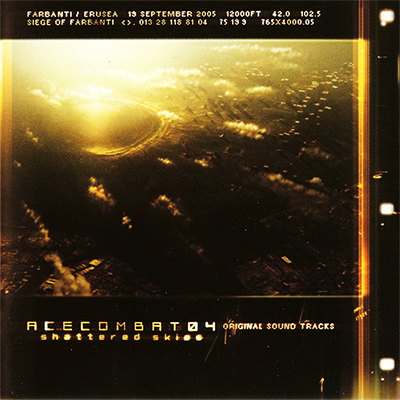
Tracks featured in Mission 15:
DISC 2

Storyboard sketches depicting parts of San Salvacion:
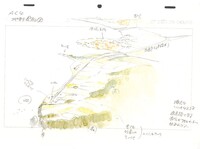
Production sketches from ACES AT WAR of the bulk of our main cast for the story segments, because this is basically the last time we’re going to see like 90% of them:
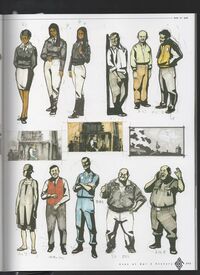
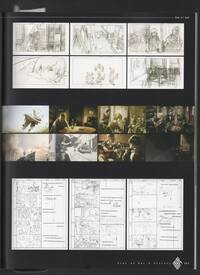
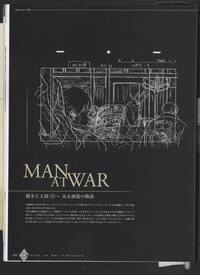
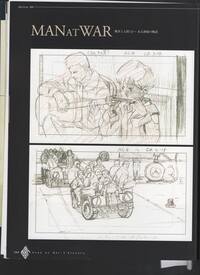
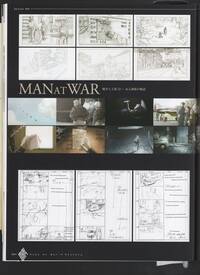
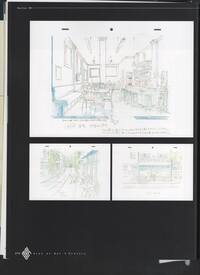
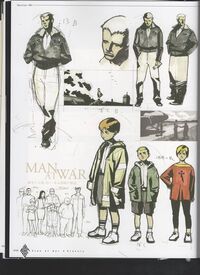
The censored frames from the pre-mission story sequence (c/o: Censored Gaming):
